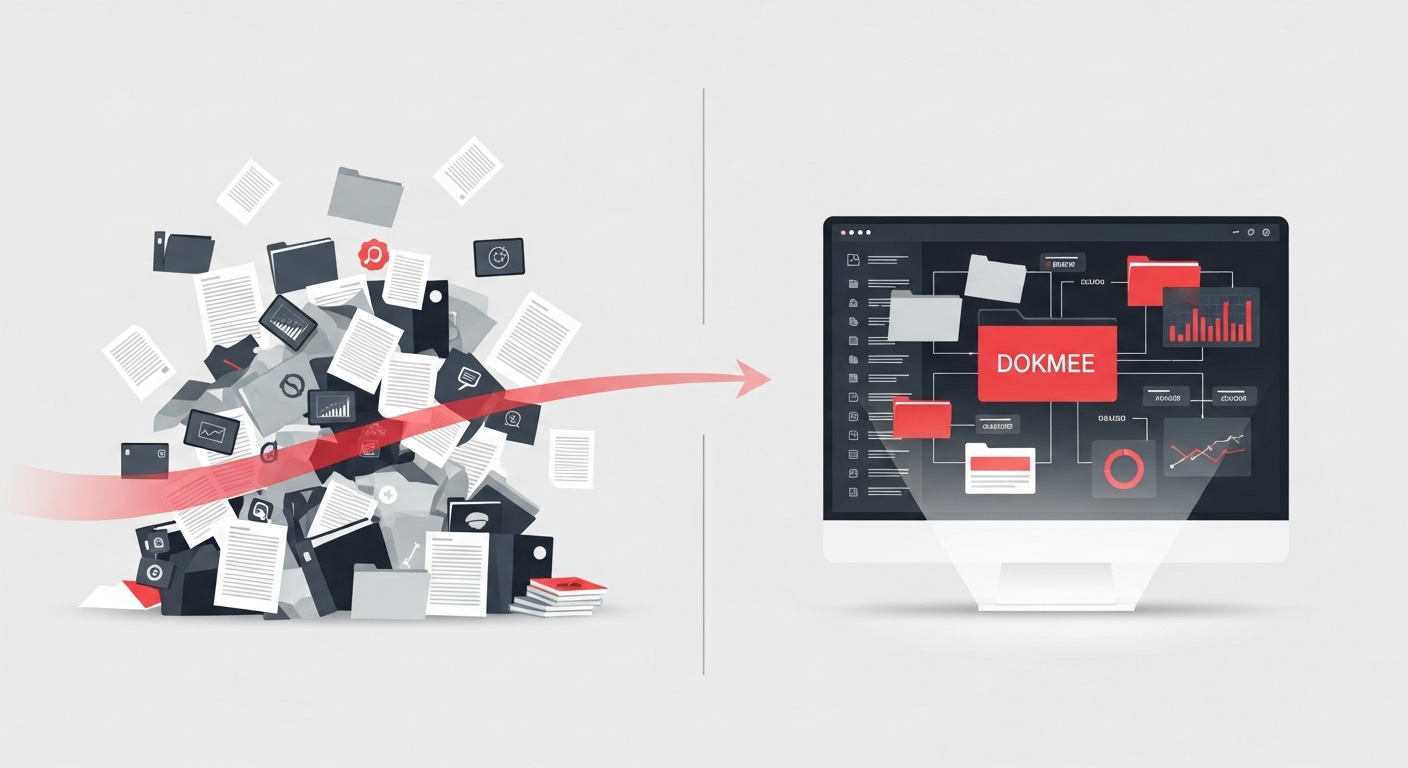According to Gartner, poor data quality costs organizations an average of $12.9 million every year. A primary cause is the time wasted searching for information and the costly mistakes that arise from manual data entry.
For most organizations, critical business information is fragmented across disconnected file servers and inboxes. This forces employees to spend up to a full workday per week manually searching for documents, which drains productivity and risks leading to mistakes that impact everything from finance to compliance.
AI document indexing solves this problem. This technology eliminates the need for manual organization and gives your team instant access to the information they need to do their jobs effectively. Continue reading to learn what it is, how it works, and how to implement it in your business.
Key Takeaways
- AI document indexing automates the slow, error-prone task of manually organizing files, giving back the 1.8 hours employees lose searching for information daily.
- It uses technologies like OCR to read documents and AI to understand their content with over 99% accuracy.
- The main benefits are saving time, reducing human error rates of 1–4%, and making information instantly findable.
- Implementing AI indexing is best done through an Enterprise Content Management (ECM) platform.
- AI doesn't just find keywords; it understands context, so you can search for concepts and ideas.
- This technology scales to handle the massive data growth projected by industry analysts.
What Is AI Document Indexing?

AI document indexing uses artificial intelligence to automatically analyze, categorize, and tag information within your documents.
It goes beyond simple keyword search by using technologies like Optical Character Recognition (OCR) to convert scanned images into machine-readable text and AI to understand the context of the data.
Manual indexing is different. It requires an employee to read and tag each file by hand. This process is slow and unreliable, and even skilled workers have a data entry error rate of around [1–4%](https://www.docuclipper.com/blog/human-error-statistics/#:~:text=When no verification steps are in place%2C the,humans could make between 100 and 400 errors.).
While that sounds small, for a business processing 10,000 documents, that’s 100 to 400 potential errors, which leads to lost files, compliance failures, and flawed business decisions. AI reduces this error rate to near zero.
Here’s how AI-powered indexing directly compares to outdated manual processes:
| Capability |
Traditional Manual Indexing |
AI Document Indexing |
| Process |
A person reads and manually tags each file. |
AI reads the text and automatically tags content. |
| Speed |
Extremely slow; a person can do a few files per hour. |
Extremely fast; the software can process thousands per hour. |
| Accuracy |
Prone to a 1–4% error rate from typos and mistakes. |
Consistently high accuracy, almost always exceeding 99%. |
| Searchability |
Only finds exact keyword matches. |
Finds information based on meaning and context. |
| Cost |
High labor costs that grow with document volume. |
Low operational cost that scales easily. |
Ready to see how intelligent indexing can transform your workflow? Dokmee’s document capture software uses powerful AI to automate your most time-consuming tasks.
[Contact Us for a Free Demo →]
How Does AI Document Indexing Work?

A modern Enterprise Content Management system (ECM) like Dokmee makes the indexing process simple and seamless. Here’s how it works:
1. Step 1: Ingest and Capture
First, documents are captured from any source. It could be a scanner, an email inbox, or direct uploads.
Dokmee’s system can be configured with automatic rules, such as grabbing all files from a specific “invoices” inbox.
2. Step 2: Recognize and Extract Data with OCR
Many business documents are scans or image-based PDFs. Optical Character Recognition (OCR) technology converts these images into searchable text. Dokmee’s AI-powered OCR achieves up to 99% accuracy, meaning it ensures no data is missed.
The AI then performs automated data extraction. It identifies and pulls key information like invoice numbers, customer names, and contract dates.
3. Step 3: Tag, Classify, and File
With the important data extract, the system automatically creates metadata tags and classifies the document.
- For example, it identifies a document as a “contract,” tags it with the client name and effective date, and files it in the correct “Active Contracts” folder.
This process does not require human intervention at all.
4. Step 4: Secure and Make Searchable
The document is now securely stored in the centralized repository, indexed, and instantly searchable.
Users can find what they need in seconds, not just by keywords, but by searching for concepts, dates, or any piece of related information.
The Benefits of AI Document Indexing

There are many benefits to moving to an AI-based system. The benefits are clear and backed by data, too.
Reduce Manual Errors
Replacing manual data entry helps you eliminate the 1–4% error rate that costs businesses millions in corrections and poor decisions. This guarantees your data is reliable and your teams work with accurate information.
Reclaim Wasted Time
Knowledge workers spend up to 2.5 hours daily just searching for information.
AI indexing gives that time back. It frees your team to focus on strategic, revenue-generating activities instead of time-consuming administrative tasks.
Find Anything
Stop searching for keywords and start finding answers.
Contextual search allows you to ask questions like “all contracts expiring in the next 90 days” and get immediate results. This task would otherwise take your employees days of manual review.
Enable Secure Remote and Hybrid Work
A centralized, cloud-accessible ECM ensures that all team members, regardless of location, can find and work with the same information securely.
All access and actions are tracked in an audit log. Governance is effectively maintained for a distributed workforce.
Increase Productivity
The amount of global data is expected to more than double between 2022 and 2026, according to IDC research.
Without an AI system in place, you’d need to spend an exponential amount of money to hire more administrative staff. AI systems can handle this explosive growth without draining your budget.
Diego Gilmour, project manager at Getir, noted, “[...] easy handling of multiple project files easily without risking any document or any business information. Dokmee ECM allows the team to work together through various projects and easily access drawings and many other files from remote areas and also the uploading is effective.”
Real-World Applications for AI Document Indexing

AI document indexing’s usefulness becomes clear when applied to specific industry challenges. Here’s how different sectors can use this technology to boost efficiency and compliance:
- Healthcare: A hospital can use AI indexing to automatically capture and classify patient records, lab results, and billing information. The system can extract patient information and ensure every document is filed correctly and is instantly accessible for audits or patient care, all while maintaining HIPAA compliance.
- Finance and banking: When processing loan applications, a bank can instantly ingest and index all supporting documents. The AI extracts financial data, flags missing information, and routes the completed application to the correct underwriter. It can reduce loan processing time from weeks to days.
- Legal firms: Lawyers can automatically index thousands of case files, contracts, and discovery documents. They can use contextual search to find every document related to a specific precedent or clause in seconds, which cuts down manual research time and strengthens their case preparation.
- Human resources: An HR department can automate the indexing of employee applications, onboarding paperwork, and performance reviews. The AI can tag documents by employee name, department, and such. It creates a complete and easily searchable employee file that ensures compliance and simplifies management.
Calculating the ROI of AI Document Indexing
The productivity gains are significant, but what truly builds the business case is the financial return on investment (ROI). You can estimate your potential ROI with a simple calculation:
1. Step 1: Calculate Time-Saving Gains
(Number of Employees) x (Hours Saved Per Week Searching) x (Average Hourly Employee Cost) x (52 Weeks) = Annual Time Savings
2. Step 2: Calculate Error Reduction Savings
(Number of Documents Processed Monthly) x (1% Manual Error Rate) x (Average Cost Per Error) x (12 Months) = Annual Error Reduction Savings
3. Step 3: Determine Your ROI
(Annual Time Savings + Annual Error Reduction Savings - Annual Software Cost) / (Annual Software Cost) x 100 = ROI %
For many organizations, the savings from eliminating costly errors and reclaiming thousands of hours of lost productivity result in a positive ROI within the first year.
How Dokmee Compares to Other ECM Platforms
Platforms like Laserfiche and M-Files offer indexing features, but Dokmee stands out with its combination of flexibility, ease of use, and powerful, AI-driven automation. Here’s how it compares to the alternatives:
| Feature |
Dokmee |
M-Files |
Laserfiche |
| Approach |
Flexible, all-in-one system for capture, indexing, and workflow. |
Metadata-driven; organizes content by “what it is.” |
Process-driven; excels at complex workflow automation. |
| AI Indexing |
Advanced OCR and AI-powered data extraction are central to its capture module. |
AI is key to its metadata-based classification. |
Strong AI capabilities for workflow automation and capture. |
| Deployment |
Ultimate flexibility: On-premises, cloud, or hybrid models. |
Primarily cloud-focused with an on-premises option. |
Cloud and on-premises options are available. |
| Ease of Use |
Highly intuitive, Windows-like interface requires minimal training. |
Moderate learning curve due to its unique metadata model. |
Steeper learning curve, often requires more configuration. |
| Target Market |
Scalable for small businesses to large enterprises across all industries. |
Best suited for large enterprises with complex information structures. |
Strong in large enterprises and regulated industries like government. |
Index Your Documents Automatically with Dokmee
The global market for Enterprise Content Management is projected to reach over $150 billion by 2032 due to the need to manage massive data growth intelligently. Organizations that fail to adopt modern tools will be left behind.
An Enterprise Content Management (ECM) system with AI document indexing is a necessity for your modern business. It transforms your document archives from a cost center into a strategic, intelligent asset.
Dokmee’s intuitive, scalable Enterprise Content Management system can simplify your document storage, automate your workflows, and boost compliance. Stop searching and start finding.
[Contact Us for a Free Demo to See Dokmee’s AI in Action →]
Frequently Asked Questions
1. What is document indexing in AI?
AI document indexing is the use of artificial intelligence to automatically read, categorize, and tag documents based on their content.
This process uses OCR and automated data extraction to make files easily searchable based on their meaning, not just keywords.
2. Can AI create an index?
Yes. AI reads a document and generates a rich index of metadata tags based on the information it contains, such as dates, names, amounts, and other useful data points. This is far more comprehensive than what a human would manually enter.
3. Can AI organize a document?
Yes. Based on its content, AI can automatically classify a document (as an invoice, contract, resume, etc.) and file it in the correct digital folder according to predefined business rules. It enables true workflow automation.
4. What is the difference between data indexing and document indexing?
Data indexing is a broad term for structuring any type of data for quick retrieval.
AI document indexing is a specific application of data indexing that focuses on understanding and organizing the unstructured content within documents like PDFs, emails, and scanned images.
5. How does Dokmee ensure the security of indexed documents?
Dokmee provides enterprise-grade security with features like a complete audit trail, granular user restrictions at the file and folder level, and integration with Active Directory to ensure only authorized users can access sensitive information.